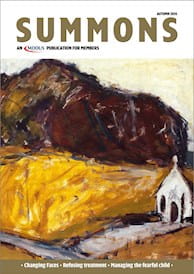
HANDS UP who has experienced a little stress when managing an anxious child patient. Okay, maybe more than a little stress. Treating the fearful child can be one of the most difficult challenges we face in dentistry and is experienced by both general dental practitioners and paediatric dentists alike. Is this stress avoidable?
Despite improvements in children’s dental health, caries continues to affect around one third of young children in the UK and with this challenging situation comes the need to consider how we can best manage treatment for the anxious child.
Establishing trust
From the first appointment, the dental practitioner should aim to establish a positive relationship based on trust with the child and parent. The triad of communication between dentist, parent and child can become complicated: young children tend to concentrate on only one individual at any given time. A smiling, welcoming dental team who show empathy to parent and child is the best start to the initial appointment.
Always make eye contact with the child, use their name and talk to them as opposed to talking over them – and aim to say something that will make them smile. These simple suggestions are excellent rapport builders and can help ensure a child is more likely to co-operate with treatment plans.1 It will come as no surprise that fear experienced in previous unhappy dental visits has been related to poor behaviour at future visits, and there is certainly merit in parents bringing children for routine dental exams from infancy so that the surgery environment becomes more familiar.2
Managing anxiety
Dental anxiety is common and occurs as a result of the reaction of the patient to perceived danger – known in physiological terms as the “fight-or-flight response”. Dental phobia is essentially a stronger reaction to the same fear, where the symptoms of the fight-or-flight response occur even when just thinking about the threatening situation. Children with a vivid imagination can create an overwhelming physical response by thoughts alone.2
Dental anxiety can be initially addressed when taking a child’s dental history. Ask questions about previous dental pain and reactions to past dental treatments. In children over eight years, a validated scale such as the Modified Child Dental Anxiety Scale (MCDAS) can be a useful assessment of the child’s level of anxiety and helpful in planning appropriate treatment strategies. The MCDAS consists of a simple 40-point scale, with children rating their level of anxiety in regard to eight specific questions on a scale of 1-5. Scores of 27-40 indicate severe dental anxiety or phobia.3
Guidelines produced by the British Society of Paediatric Dentistry describe a full range of behaviour management techniques and suggested situations for use in dental anxiety.2The chosen management technique should be based on individual circumstances; no single method will be applicable in all situations.
Mild to moderate anxiety
Fear of the unknown can often be easily diminished with good rapport building and empathy. The following techniques can be useful:
Positive reinforcement. Use stickers, colouring sheets or simply verbal praise to reward the child when they co-operate well. Keep praise and rewards specific: “Well done for keeping your mouth open so well” is more effective than “good boy”. Asking the child how they are doing during treatment, communicating with thumbs up, has been shown to be more effective than reassurance.
Tell-show-do. Although requiring time at the initial treatment appointment, this technique is an excellent way to introduce patients to new experiences, increasing the chance of future co-operation. This might include using the three-in-one on the child’s hand prior to drying teeth or demonstrating the slow-speed on a finger-nail prior to caries removal. Should the child ask to see the local anaesthetic prior to injection, show them the individual components and emphasise how fine and thin the needle is and how little of it needs to touch the gum.
Voice control. This is especially helpful with young children who respond better to tone of voice rather than actual words, switching to a different, slightly sterner tone when necessary to improve attention, compliance and establish authority.
Distraction. Short-term distracters are useful, for example chatting and pulling the lip taut to distract from the sensation of local anaesthetic (and always dry mucosa before using topical, allowing four minutes for it to work!). If facilities allow, playing a cartoon on a ceiling television screen during treatment has been demonstrated as being effective.
Giving control. Be honest with the child. If you set up a stop-signal, promising that you will stop if the patient indicates for this to happen, you must adhere to it. Not doing so can have disastrous consequences with the breakdown of trust between patient and dentist.
More severe cases of anxiety
If it becomes clear during the initial appointment that the patient has more severe anxiety, additional strategies will be necessary. These might include conscious sedation, general anaesthetic or non-pharmacological techniques such as cognitive behavioural therapy or hypnosis. It may be appropriate to refer the patient to the local public dental service or paediatric dental department for further assessment.
Other points for consideration
Avoidance. Consider when treating children that your aim is not only to prevent and treat dental disease but also to avoid treatment-induced anxiety. Consider the holistic needs of the child when treatment planning. For example, a child with pulpitis in one primary molar may well have a number of other carious teeth that also need to be taken into consideration. Take appropriate radiographs and consider how other carious teeth will be managed. Prioritise prevention of caries in permanent molars and where possible avoid carrying out an extraction at the first dental appointment.
Parent in or out? Some dentists prefer one-to-one interaction with a child without the parent/carer present. Research suggests, however, that cooperation is widely unaffected by having a parent present in the surgery or not. In the case of pre-school children, however, behaviour tends to be better when a parent is with them.
Watch your language. Take care with your choice of words. “Don’t be scared, I’m not going to hurt you” will unfortunately do little to alleviate anxiety. Negatives like “Don’t” and “not” tend to be bypassed by the mind – a little like telling a child not to look out the window, it becomes the first thing that they do! Focus instead on positives: “You will manage this just fine” and “lift up your hand if you need a break and I’ll stop”.
Failed appointments. Dental anxiety is often cited as a reason for not attending dental appointments. However, children deserve access to dental care and require a responsible adult to get them there. It can help by explaining via letter or telephone that the first visit is for assessment and planning only. If a parent or guardian is repeatedly failing to bring their child to their scheduled appointment or only bringing the child when they are in pain, discuss your concerns with an appropriate colleague. All concerns should be fully documented and local health board protocol followed.4
Check out www.dental.llttf.com for valuable downloadable resources aimed at dental practitioners, young people and their parents on coping with dental anxiety, including leaflets on how to prepare children for their dental visit. The website was produced by a team of researchers in the UK, experienced in research and treatment regarding anxious young people.
Treating children can certainly bring its challenges, but careful planning and management can go a long way towards easing the stress for patient and dentist alike.
Fiona Hogg is a specialty registrar in paediatric dentistry at Glasgow Dental Hospital and the Royal Hospital for Children, Glasgow
REFERENCES
- Prevention and Management of Dental Caries in Children. Scottish Dental Clinical Effectiveness Programme. Dundee 2010 http://www.sdcep.org.uk/ published-guidance/caries-inchildren/ (accessed 3.7.16)
- Campbell C, Soldani F, Busuttil-Naudi A, Chadwick B. Update of Nonpharmacological behaviour management guideline. Clinical Guidelines in Paediatric Dentistry http://bspd.co.uk/Portals/0/ Public/Files/Guidelines/ Non-pharmacological%20 behaviour%20 management%20.pdf (accessed 3.7.16)
- Freeman R. An evaluation of the PALS after treatment modelling intervention to reduce dental anxiety in child dental patients. 2009 International Journal of Paediatric Dentistry 19(4):233-42
- Children and Young People (Scotland) Act 2014 http://www.legislation.gov. uk/asp/2014/8/contents/ enacted (accessed 3.7.16)
This page was correct at the time of publication. Any guidance is intended as general guidance for members only. If you are a member and need specific advice relating to your own circumstances, please contact one of our advisers.
Read more from this issue of Insight

Save this article
Save this article to a list of favourite articles which members can access in their account.
Save to library
